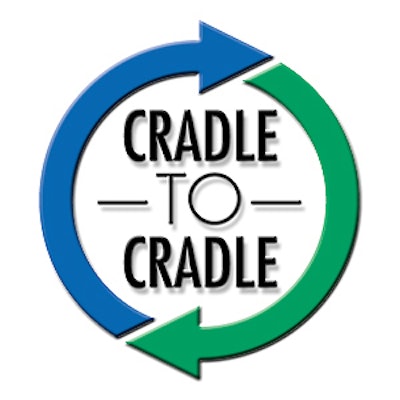A new book, Cradle to Cradle: Remaking the Way We Make Things, by architect William McDonough and chemist Michael Braungart, sets forth an entirely different vision for environmentally effective products and packaging (see separate story, p. 62). To gauge the packaging field’s reaction to this new philosophy, we floated the cradle-to-cradle idea to several companies in a survey on Packworld.com. The vast majority personally supported the idea of a cradle-to-cradle packaging initiative at their companies (see chart). And half said their company would be receptive to such an initiative.
This research comes with two important caveats. First, survey respondents read only a brief paragraph summarizing the cradle-to-cradle concept, versus the authors’ entire book. Second, when it comes to packaging and the environment, there has always been a big difference between what people say in a survey and what they actually do in real life.
Nevertheless, the findings are significant on two counts. First, it’s often assumed by people outside the packaging field that people in the field do not care about the environment because they are associated with the manufacture and use of packaging. That couldn’t be further from the truth, a fact that is documented by the findings of the survey.
Second, the research documents an awkward disconnect between what packaging people want as individuals versus what their employers require for their businesses to run smoothly.
Sound thinking
We also interviewed some key packaging people to get their reaction to the cradle-to-cradle concept. A few who knew of the concept reacted favorably when contacted for this report, but they could not obtain permission to speak to us on behalf of their companies.
One person who is familiar with the cradle-to-cradle concept is Graham Houlder, global packaging coordinator for Unilever Bestfoods, based in the Netherlands. That company is embarking on a global sustainable packaging strategy that echoes the cradle-to-cradle philosophy.
“The thinking is very sound,” Houlder said, regarding cradle-to-cradle. However, for food packaging, Houlder has doubts about biodegradability. “The current biopolymers that are out there don’t offer us the barrier properties we need for our food products. If you’re going to biodegrade something, you need it to be sensitive to heat, moisture, oxygen, and probably light, and those are the things we try to barrier our products against.”
A representative from one leading supplier of biopolymers takes such constructive criticism in stride. “No one polymer is perfect for every application,” acknowledges Michael O’Brien, communications manager for Cargill Dow Polymers. Cargill Dow manufactures NatureWorks™ PLA, a polymer derived from renewable resources such as corn. “We focus on where it does work—in our case, fresh prepared foods for grocery retailers,” says O’Brien. “The barrier properties are suitable for it. Grease- and aroma-resistance are our strong performance benefits.”
Unilever’s Houlder also points out that reusability and returnability are obviously a problem for single-use food packaging. “Legislation prevents us from using recycled materials in direct contact with food because of the risk of contamination. The only real technical cycle that would allow us to do that is, for example, the repolymerization of PET.”
For the moment, Unilever’s sustainable packaging effort is focusing on paper. “For our cartons and shippers, we’re looking at how much fiber comes from forests that are being replanted, versus indigenous forests that are not being replaced,” says Houlder. “We’d like to move to a completely certifiable source for 100% of the packaging.”
Is Unilever willing to pay an upcharge for sustainable packaging? “That decision hasn’t been made yet,” says Houlder. “But we’d be hard-pressed to see a reason why, particularly in the paper area, we should take on cost. In the future, there should be plenty of sources of sustainable fiber.”
Moving to the next level
Another convert to the cradle-to-cradle concept is John Delfausse, vp of packaging at Minneapolis-based Aveda, a maker of upscale cosmetics and health and beauty products.
“The whole concept makes an awful lot of sense,” says Delfausse. Aveda is already pushing post-consumer-recycled (PCR) content of its packaging to unprecedented levels (see p. 74). But Delfausse says the company is looking to move to the next level of sustainable packaging. Closures could be a test case. Currently all Aveda’s closures use virgin polypropylene resin. In an attempt to create a PCR PP closure, the company’s suppliers have been hampered by supply issues.
“Based on the whole cradle-to-cradle concept, we realized we’ve got a tremendous source—all of our consumers. If we could actually ask our customers to return our caps, we’d have an unlimited source of PP that could go back into the same sort of caps.”
Delfausse acknowledges there’s not currently an effective infrastructure for returning closures, most of which are PP. Many closures aren’t marked with the Society of the Plastics Industry’s chasing-arrows recycling coding; and, even if they were, PP is simply not recycled in any significant volume in this country.
A solution might involve placing a collection bin in stores where its products are sold, or possibly examining some sort of deposit system similar to soft drinks, according to Delfausse. Still, Aveda would have to overcome history. The company tried to collect its packaging years ago, and “we got everybody’s garbage,” says Delfausse.
Yet he remains undeterred. “What cradle-to-cradle really does is get the industry to start thinking about what we need to do to collect these things,” he says. For now, Aveda will investigate conducting a closure collection program in a limited market test.
Reusability can be tough
Alison Kent, manager of the global corporate packaging team at Hewlett-Packard, was reading the book at the time we went to press. “The case that [the authors] lay out seems very provocative,” she says. However, returnable packaging would nevertheless be challenging for HP. “We change our products so frequently that there’s only a limited period when the packaging material would be relevant to reuse,” she says.
Regarding the argument that cradle-to-cradle can be done at the same or lower cost, she responds, “In our own investigations to use more environmentally responsible materials and designs, it’s often at a cost. That’s always the trade-off.” But, Kent allows, “what we’ve been looking at is one slice of the whole system cost. So maybe if you look at it end to end, it can be less.”
Although there are many obstacles to be overcome before the cradle-to-cradle concept can be said to have caught on in the packaging arena, a growing number of packagers and suppliers are showing interest. That’s why Cradle to Cradle authors McDonough and Braungart are hosting a one-day industry meeting July 11, at which attendees will receive an overview of the cradle-to-cradle philosophy and will discuss whether to form a working group focusing on cradle-to-cradle package design. For details, visit the link below.
Respondents describe how their companies think about packaging and the environment at: packworld.com/go/w091


























